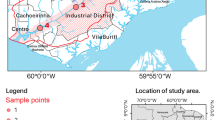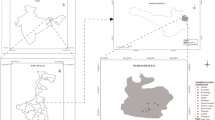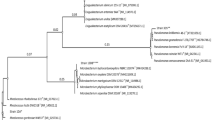Abstract
Nowadays, the use of pesticides as plant protection products has become widely prevalent, leading to the entry of large amounts of pesticides into soil and water resources, and subsequently, a threat to the environment. The objective of this study was molecular identification and resistance investigation of atrazine degrading bacteria in the sediments of Karun River, Ahvaz, Iran. Nine samples were collected in both summer (Jul) and autumn (Nov) year 2012 from a depth of 3 to 5 cm of the sediments. Atrazine degrading bacteria were enriched in a culture containing atrazine with initial concentration of 30 mg/L. Identification of isolated bacteria was performed by morphological and biochemical test and molecular analysis based on 16S rDNA sequencing. The atrazine biodegradation rate was obtained by high-performance liquid chromatography (HPLC). Six strains was identified including Achromobacter insolitus strain F-N3, Delftia tsuruhatensis strain F-N4, Klebsiella pneumonia F-N1, Enterobacter ludwigii strain F-N5, Serratia marcescens strain F-N6 in both summer and autumn, and Exiguobacterium profundum strain F-N2 only in the summer. The minimum inhibitory concentration (MIC) of atrazine showed that the most resistant species belonged to E. ludwigii F-N5 and D. tsuruhatensis F-N4 in the both seasons. The atrazine degradation rates of the two strains reached 90 and 85%, respectively after 7 days culture. Result showed that indigenous bacteria in the Karun River can degrade the atrazine effectively.
Similar content being viewed by others
References
Ma, W.T., Fu, K.K., Cai, Z., and Jiang, G.B., Gas chromatography/mass spectrometry applied for the analysis of triazine herbicides in environmental waters, Chemosphere, 2003, vol. 52, no. 9, pp. 1627–1632.
Seiber, J.N., Glotfelty, D.E., Lucas, A.D., McChesney, M.M., Sagebiel, J.C., and Wehner, T.A., A multiresidue method by high performance liquid chromatography-based fractionation and gas chromatography determination of trace levels of pesticides in air and water, Arch. Environ. Contamin. Toxicol., 1990, vol. 19, no. 4, pp. 583–592.
Dehghani, M., Nasseri, S., Amin, S., Naddafee, K., Taghavi, M., and Yunesian, M., Isolation and identification of atrazine-degradating bacteria from corn field in Fars province of Iran, Pakistan J. Biol. Sci., 2007, vol. 10, no. 1, pp. 84–89.
Abigail, M, E.A. and Das, N., Microbial degradation of atrazine, commonly used herbicide, Int. J. Adv. Biol. Res., 2012, vol. 2, no. 1, pp. 16–23.
Zhang, Y., Ning, Z., Zhao, J., Xinran, P., Shuyan, M., and Miao, H., Isolation of two atrazine-degrading strains and their degradation characteristics, Int. J. Agric. Biol. Eng., 2009, vol. 2, no. 3, pp. 27–33.
Behlci, R.M. and Khan, S., Degradation of atrazine propazine and simazine by Rhodococcus strain B-30, J. Agric. Food. Chem., 1994, vol. 42, pp. 123–124.
Garcia-Gonzalez, V., Govantes, F., Porrua, O., and Santero, E., Regulation of the Pseudomonas sp. strain ADP cyanuric acid degradation operon, J. Bacteriol., 2005, vol. 187, pp. 155–167.
Struthers, J.K., Jayachandran, K., and Moorman, T.B., Biodegradation of atrazine by Agrobacterium radiobacter J14a and use of this strain in bioremediation of contaminated soil, Appl. Environ. Microbiol., 1998, vol. 64, no. 9, pp. 3368–3375.
Bouquard, C., Ouazzani, J., Prome, J., Michel-Briand, Y., and Plesiat, P., Dechlorination of atrazine by a Rhizobium sp. isolate, Appl. Environ. Microbiol., 1997, vol. 63, no. 3, pp. 862–866.
Mougin, C., Laugero, C., Asther, M., Dubroca, J., Frasse, P., and Asther, M., Biotransformation of the herbicide atrazine by the white rot fungus Phanerochaete chrysosporium, Appl. Environ. Microbiol., 1994, vol. 60, pp. 705–708.
Radosevich, M., Traina, S.J., Hao, Y.L., and Tuovinen, O.H., Degradation and mineralization of atrazine by a soil bacterial isolate, Appl. Environ. Microbiol., 1995, vol. 61, no. 1, pp. 297–302.
Cai, B., Han, Y., Liu, B., Ren, Y., and Jiang, S., Isolation and characterization of an atrazine-degrading bacterium from industrial wastewater in China, Lett. Appl. Microbiol., 2003, vol. 36, no. 5, pp. 272–276.
Baluch, H.U., Somasundaram, L.R., Kanwar, S., and Coats, J.R., Fate of major degradation products of atrazine in Iowa soils, J. Environ. Sci. Heal. A, 1993, vol. 28, pp. 127–149.
Kafilzadeh, F., Amiri, P., Rezaeian, J.A., and Mojoodi, N., Isolation and molecular identification of fluoranthene degrading bacteria from the mangrove sediments in South of Iran, Int. J. Biosci., 2013, vol. 3, no. 5, pp. 60–66.
Coral, G. and Karagoz, S., Isolation and characterization of phenanthrene degrading bacteria from a petroleum refinery soil, Ann. Microbiol., 2005, vol. 55, no. 4, pp. 255–259.
Haghnia, G.H. and Razavi, E., Remediation of Soil and Water Contaminated with Pesticides, 1st ed., Tehran: Environmental Protection Agency, 2008.
Sene, L., Converti, A., Secchi, G.A.R., and Simao, R.C.G., New aspects on atrazine biodegradation, Braz. Arch. Biol. Technol., 2010, vol. 53, no. 2, pp. 487–496.
Li, Q., Li, Y., Zhu, X., and Cai, B., Isolation and characterization of atrazine-degrading Arthrobacter sp. AD26 and use of this strain in bioremediation of contaminated soil, J. Environ. Sci., 2008, vol. 20, no. 10, pp. 1226–1230.
Ngigi, AN., Getenga, Z.M., Boga, H.I., and Ndalut, PK., Biodegradation of s-triazine herbicide atrazine by Enterobacter cloacae and Burkholderia cepacia sp. from long-term treated sugarcane-cultivated soils in Kenya, J. Environ. Sci. Health. B, 2012, vol. 47, no. 8, pp. 769–778.
Vargha, M., Takats, Z., and Marialigeti, K., Degradation of atrazine in a laboratory scale model system with Danube River sediment, Water Res., 2005, vol. 39, no. 8, pp. 1560–1568.
Boundy-Mills, K., de Souza, M.L., Mandelbaum, R.M., Wackett, L.P., and Sadowsky, M.J., The atzB gene of Pseudomonas sp. strain ADP encodes the second enzyme of a novel atrazine degradation pathway, Appl. Environ. Microbiol., 1997, vol. 63, no. 3, pp. 916–923.
Ostrofsky, E.B., Robinson, J.B., Traina, S.J., and Tuovinen, O.H., Analysis of atrazine-degrading microbial communities in soils using most-probable-number enumeration, DNA hybridization, and inhibitors, Soil Biol. Biochem., 2002, vol. 34, pp. 1449–1459.
Khan, M.S., Chaudhry, P., Wani, P.A., and Zaidi, A., Biotoxic effects of the herbicides on growth, seed yield, and grain protein of greengram, J. Appl. Sci. Environ. Manage., 2006, vol. 10, no. 3, pp. 141–146.
Silver, S. and Phung, L.T., Bacterial heavy metal resistance: new surprises, Annu. Rev. Microbiol., 1996, vol. 50, pp. 753–89.
Talaro, K.P., Foundations in Microbiology, Basic Principles, 7th ed., New York: McGraw-Hill, 2008.
Author information
Authors and Affiliations
Corresponding author
Additional information
The article is published in the original.
Rights and permissions
About this article
Cite this article
Kafilzadeh, F., Farhadi, N. Molecular identification and resistance investigation of atrazine degrading bacteria in the sediments of Karun River, Ahvaz, Iran. Microbiology 84, 531–537 (2015). https://doi.org/10.1134/S0026261715040098
Received:
Published:
Issue Date:
DOI: https://doi.org/10.1134/S0026261715040098




